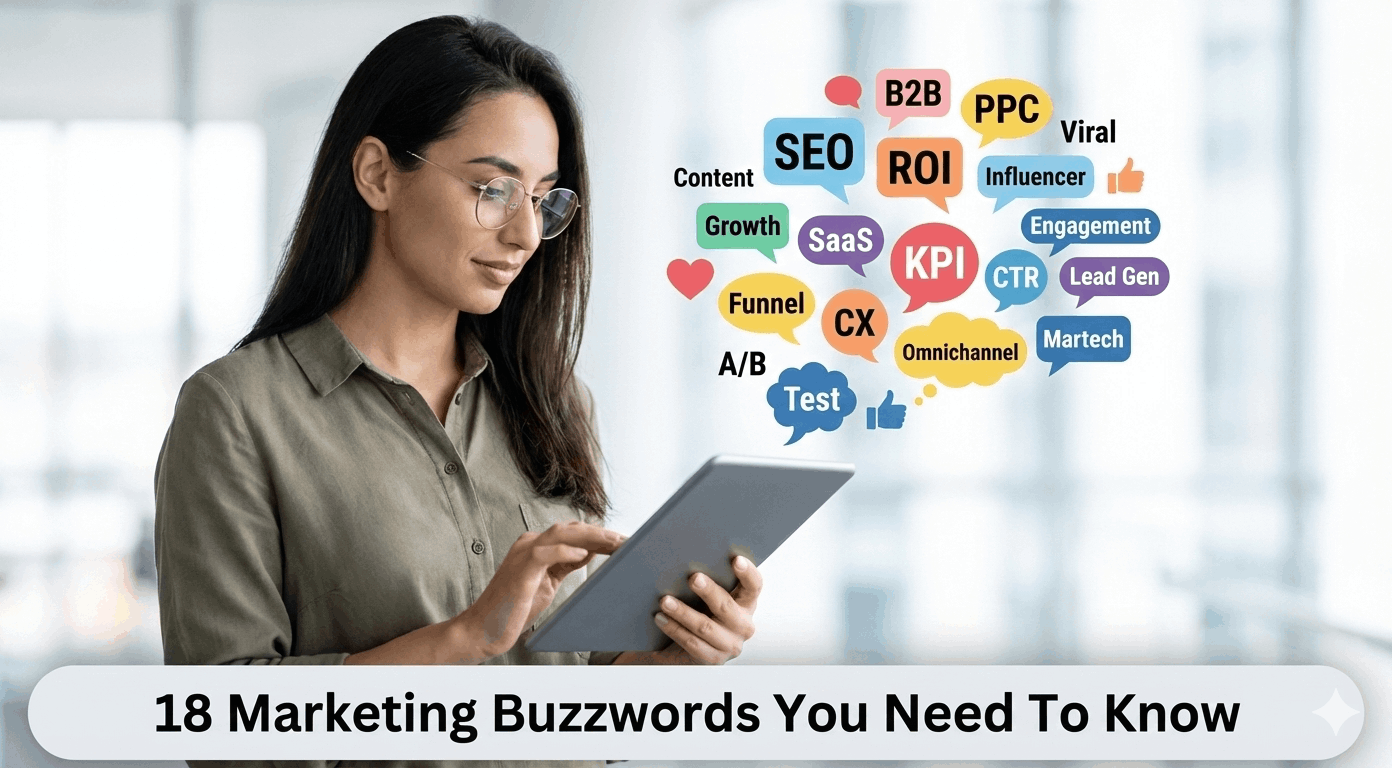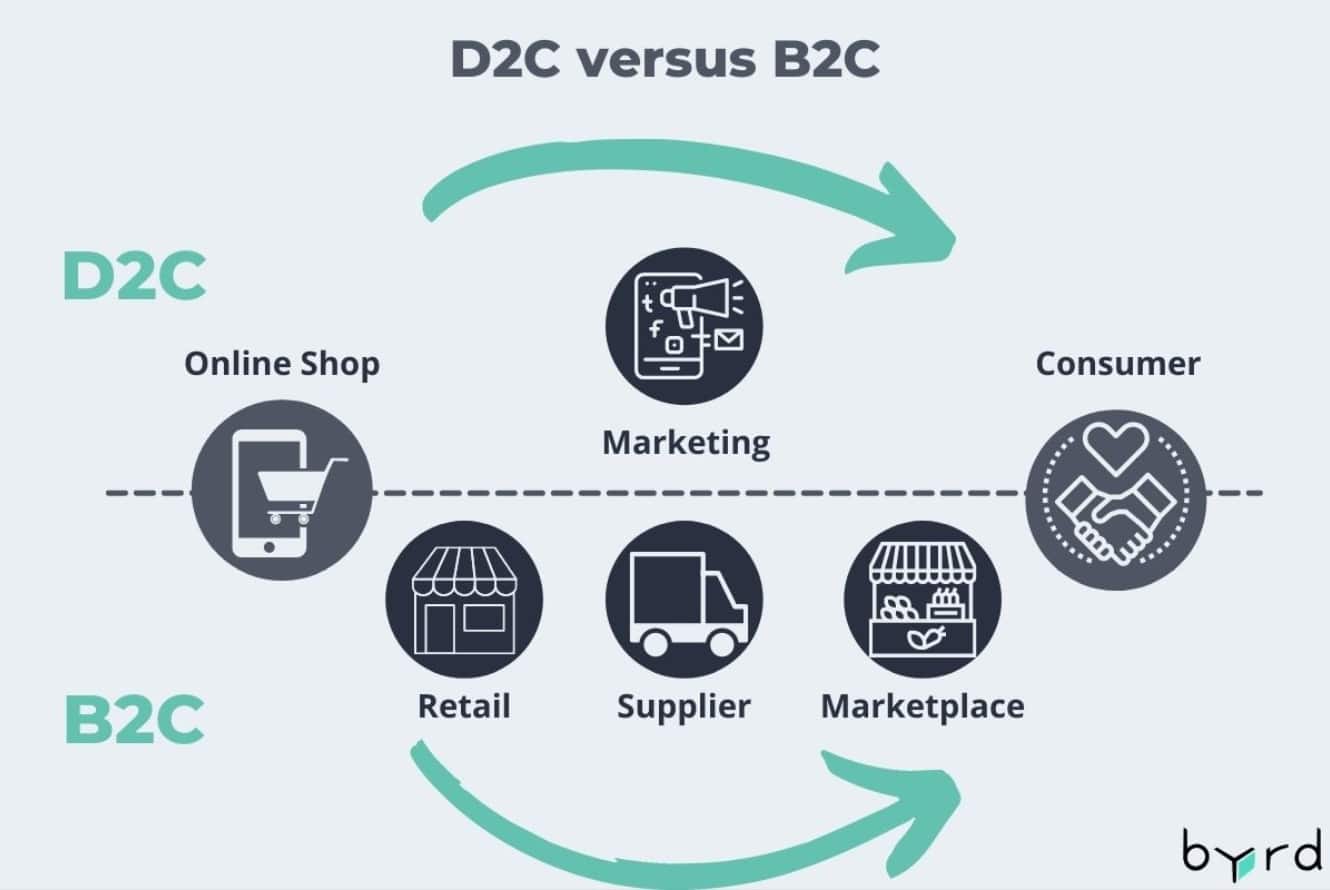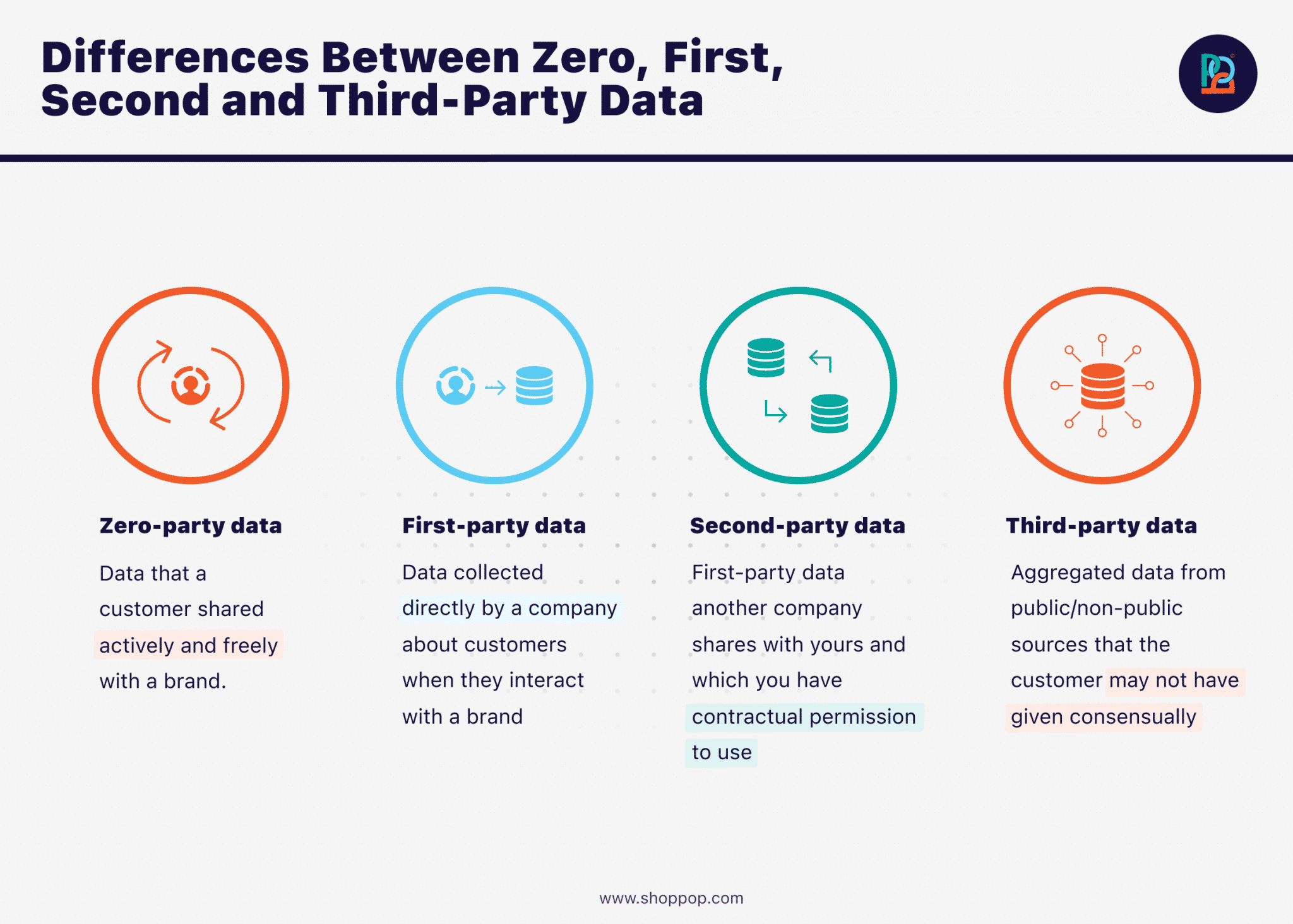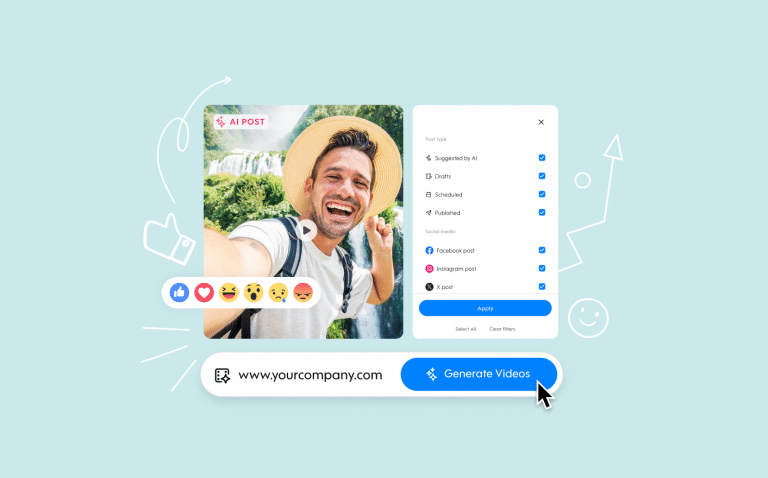
18 Marketing Buzzwords You Need To Know
Key Takeaways
- Buzzwords Have Purpose: Modern marketing buzzwords reflect real industry shifts that help businesses stay relevant.
- AI Is a Game-Changer: AI and first-party data improve personalization, efficiency, and overall customer experience.
- Purpose Builds Loyalty: Brand purpose and inclusive messaging help create deeper emotional connections with audiences.
- Omnichannel Is Essential: Strategies like cross-posting, SoLoMo, and Phygital experiences maximize reach and consistency.
- Credibility Drives Growth: Social proof, thought leadership, and trendjacking boost trust, engagement, and visibility.
When you are marketing your business without being a full-time marketer, you have to constantly come across new terms that jump out of nowhere, though it may seem confusing initially. These marketing buzzwords may contain the secret to cracking your business growth and achieving the desired marketing outcomes.
New practices and tools often require new vocabulary in a field where innovation leads and new platforms and features are launched regularly. To market your business effectively, you will want to have these terms at your fingertips and disposal.
So we’ve compiled a list of the popular digital marketing buzzwords that anyone dealing in the marketing space should be familiar with. These terms may appear daunting at first, especially if you’re new to digital marketing.
However, they play an essential role in developing effective online campaigns. They will also help you understand the best strategies and tools you can use in your marketing arsenal.
We’re here to teach you how to use them to optimize your digital marketing strategy.
Let’s get started.
1. Artificial Intelligence (AI)
You have probably heard the name Artificial Intelligence more than once. You may not have noticed how this complicated term can be useful, applicable, and affordable to your business.
In recent years, artificial intelligence has taken over the tech world and is now redefining how brands handle operations and marketing activities. These marketing buzzwords are becoming essential parts of every marketer’s bag, and knowing the buzzwords strengthens your marketing vocabulary.
Also known as AI, artificial intelligence describes the intelligent behavior of machines with a human-like ability to make decisions, perform actions, and improve by learning from experience. In a nutshell, AI automates tasks and improves efficiency and productivity.
While big companies were the first to embrace the new technology, small and medium-sized businesses also discovered the benefits. With many companies launching AI tools that focus on day-to-day business challenges, there will soon be AI solutions for many of the problems you may encounter while running a business.
Some of the more practical AI tools for small businesses deal with branding and copywriting. There are affordable, user-friendly companies doing everything they can to make AI accessible for small businesses.
One great example of this is Tailor Brands. Tailor Brands is a small business branding and logo maker that uses an AI algorithm to advise different colors, fonts, shapes, and styles based on your brand’s selections and details. Another great example is Anyword, a copywriting tool that helps automate marketing messages and captions for all social media platforms.
In addition to these, with the power of AI, you’ll find tools that:
- Develop effective marketing strategies
- Optimize the customer journey
- Create fast SEO friendly content
- Improve the way you attract, nurture, and convert prospects
- Improve your customer experience
One such groundbreaking technology that has been developed in this area is PromoAI, our high-tech app that can utilize the power of AI to transform social media management.
PromoAI automatically creates, publishes, and schedules social media videos, blending original and engaging copy, footage, music, and branding that fit your business requirements. This is the tool that illustrates how AI can be used to simplify content creation so that your social media plan can be both impactful and efficient.
These AI-generated suggestions helped Starbucks increase average order value and sales. They can help you with your business as well.
-
Brand Purpose
With more conscientious customers exposed to an endless array of choices, price and product quality are no longer sufficient to differentiate your brand. Brand purpose is what makes the company exist even when it is not making profits.
Basically, it is about your desire to leave the world a better place in the process of achieving your business objectives. Today, consumers desire to identify themselves with a brand whose values are similar to theirs. That is why brand purpose has emerged as an important yardstick in selecting companies to do business with.
Most companies know what they do and how they do it. But the “why” is the missing piece of the puzzle. Sharing “why your company exists” can help you build credibility, unlock brand loyalty, and gain a competitive advantage.
If you’re looking to create a powerful brand purpose, it should be related to your offerings. For example, if you’re in the health and nutrition section, your goal might be to improve your quality of life. Let’s say you’re in the educational sector. Your brand’s purpose might be to help young people shape their future.
For example, Dove’s brand purpose goes beyond selling beauty care products. They’ve created several campaigns around their brand purpose of promoting beauty, positive body image, and self-esteem in women. This message aligns with their beauty care products and touches on issues that resonate with customers on a deeper level.
Other brands such as Nike, Lush, Muji, and Crayola are doing it right with their brand purpose.
In case you want to build your brand purpose, the customer should be the first thing that comes to mind. Consider something that your audience cherishes and base your brand purpose on it.
The best way to communicate your brand purpose?
Not necessarily on your website’s about page. That might be a good start, but customers will need more. Your brand purpose should be apparent in your social media content at least as regularly as you promote a sale.
The fastest and easiest way to achieve that is through educational and thoughtful content. Let’s say that you are a shopping portal that also promotes artisans and local creators. You would want to promote small businesses to illuminate your message. A video like this might be a great choice:
-
Cross-Posting
Nowadays, in the era where companies and marketers are trying to stay relevant, cross-posting on your social media pages is one of the ways to increase the number of viewers and save time in the process. It is a simple and fast method of publishing content at more than just one place.
For example, when you produce a Summer Sale promotional video, you can cross-post the same video to all your social networks.
Cross-platform social media posting can be a money and time saver, especially for small businesses with limited resources. Rather than invest the time and effort in creating content for each platform, you can repurpose the content and reach a wider audience.
In addition to saving time and money, another advantage of cross-posting is brand recognition. The average social media user is active on six separate platforms and spends two and a half hours on social media daily. If they see the same content on multiple platforms, they’ll get more impressions, and their association with your brand will increase.
When crossposting, your biggest issue might be resizing your videos and photos for the different platform recommendations. For example, Instagram video sizes vary from YouTube video sizes, and each social media platform also has several different formats.
You can also go a step further with Promo by taking cross-posting. We have a Publish Page where you can publish your content on the most popular social media sites and save time and energy in terms of sharing your content. However, the best thing is that with Promo, you can easily resize any video to all three primary social media video aspect ratios.

4. Customer Lifetime Value (CLV)
When you need to acquire and retain valuable customers and achieve business growth, you should study customer lifetime value and its measurement. Customer lifetime value (CLV) reflects the total revenue of your business from a single customer during the business relationship.
But why keep an eye on your CLV?
First, monitoring your CLV helps you boost customer retention. According to Marketing Metrics, the probability of selling to new prospects is about 5%–20%, while selling to an existing customer is about 60%–70%.
This means that it costs less to retain existing customers than to acquire new ones. Plus, repeat purchases can drive in more profits and business growth.
With regular customers, you’ll have an opportunity to sell, cross-sell, and upsell your products. Typically, they spend more money on your products, helping you build, grow, and promote your brand. You can calculate CLV by multiplying the average purchase value, the number of purchases, and the customer lifespan.
For example, let’s say you run a food chain, and an average customer spends $65 per visit once every week (52 times per year) over a 10-year relationship. So your CLV will be 65 x 26 x 10 to give you a value of $16,900.
By estimating the value that a customer adds to your business (CLV), you can:
- Identify customer segments that get the most value for your business
- Define your marketing and customer retention goals
- Evaluate how much you should invest in customer retention
- Plan marketing spend to lower customer acquisition costs, keep retention high, and increase the customer lifetime value
- Deliver meaningful experiences to retain them and ultimately enjoy brand loyalty.
-
Digital Maturity
Digital maturity is defined as the capacity of a brand or marketer to react promptly, adapt, and take advantage of disruptive technological trends. It frequently involves leveraging evolving digital technology to upscale the tech aspect of your business and remain relevant with essential buzzwords for marketing that guide modern strategy.
One of the major driving forces for digital maturity is the neck-breaking speed at which technology is evolving. It’s no news that digital technology is changing the dynamics and future of business. Hence, brands must become digitally mature or risk being left behind—especially as digital buzzwords continue to reshape the competitive landscape.
Whether you’re a new or existing business, digital maturity shouldn’t be an end goal. Instead, it should be a continuous process throughout your company’s life cycle.
What’s in it for you?
According to Deloitte, 43% of digitally mature companies enjoy higher net profits than industry averages.
Understanding your brand’s digital maturity is the key to creating value and driving profitable business outcomes with digital technologies. Even more digitally mature brands enjoy perks like:
- Revenue growth
- Product quality
- Cost efficiency
- Customer satisfaction
- Competitive advantage
Given the digital contribution to business growth, the disparity between digitally mature companies and laggards will continue to expand. Without a digital maturity plan, you might not be able to scale, and you might lose to the competition.
To assess your digital maturity level, you can use the digital maturity benchmark tool developed by Google and the Boston Consulting Group. This model focuses on leveraging data to achieve digital maturity in all areas of your business.
-
Direct to Consumer (D2C)
D2C isn’t just a marketing term; you should keep it at the top of your mind. Instead, it’s an essential marketing strategy that has helped redefine the consumer-brand relationship and even shape new content marketing buzzwords used across the industry.
The emergence of social media has given brands direct access to their potential customers. This way, businesses may utilize data to develop distinctive, personalized, and more effective service experiences.
Research reports predict that D2C business models will grow monumentally in the next few years. This has been boosted by the emergence of e-commerce and the internet.
If you’re looking to launch a D2C channel and you want to edge the competition, here’s what you should do:
- Engage customers across different touchpoints, including in-store, website, vlogs, blogs, and all social channels
- Gather customer feedback and use it to improve product and service experiences
- Deliver personalized service and experiences that make customers feel valued and keep them coming back for more
Direct-to-consumer marketing empowers brands to cut out the middlemen. It enables marketers to build strong connections with customers and amass a community of loyal followers.
Some brands that have achieved success by adopting a direct-to-consumer business model include Glossier, Warby Parker, BarkBox, Casper, Dollar Shave Club, and many more.
Bypassing intermediaries to engage users directly means these companies enjoy complete control over price, sales, profit margins, and service quality. One of the biggest wins of the D2C model is the ability to have direct access to customer data and feedback.
That means you’ll have an incredible opportunity to:
- Control your supply chain
- Improve service quality and
- Deliver share-worthy customer experiences.

For an industry that is well established in the traditional retail model, the D2C model enabled them to drop prices, win customers, and experience massive growth. For example, prior to the entry of Warby Parker into the market in 2010, eyeglasses were expensive. The company shook the eyeglass industry by establishing an online storefront to allow customers to get high-quality eyeglasses at an affordable price easily.
-
Diversity, Equity, and Inclusion (DEI)
Diversity, Equity, and Inclusion have been significant talking points in society for many years. The marketing world isn’t left out. Now the business case has become more vital than ever.
Research shows that consumers readily align with brands that share similar values with them right off the bat, as DEI has become a significant differentiator for many brands. It’s no surprise. About 90% of campaigns with diverse representation experience a higher recall rate, especially when paired with powerful advertising buzzwords that resonate emotionally.
What is Diversity, Equity, and Inclusion, and why does it matter?
Diversity, equity, and inclusion (DEI) involve creating an environment where everyone, regardless of their differences, has the opportunity to participate, contribute, and thrive.
These differences include color, race, ethnicity, culture, gender, age, religious commitment, sexual orientation, language, socio-economic status, ability, and political perspective.
While planning your digital marketing strategy, you want to ensure your messaging, content, and offers meet these criteria.
Diversity
This means it should cater to a diverse group of people. In other words, everyone should be invited to the party.

Equity
This means everyone should have a fair chance. No one should be left out. You can achieve this by communicating your messages across multiple mediums and channels.
For example, TikTok and Instagram appeal more to Millennials and Gen Z audiences. Therefore, limiting your content to these channels may rob older generations of the opportunity to take advantage of your offers.
Inclusion
If your business has a website, ensure that it meets all accessibility laws and recommendations. It means that your message and the information must be available to all, even those with disabilities. For example, Promo subtitle maker allows you to add subtitles to your video with a single touch, making it accessible for people with hearing loss or who are hard of hearing.
-
Engagement
Engagements are used to measure user interactions across websites, apps, social services, and other interfaces. The conventional metrics and indicators of measuring website engagement are:
- Pageviews
- Traffic sources
- Average time on site
- Average session duration
- Pages per session
- Bounce rate
- Unique visitors
- New and repeat visitors
Engagement doesn’t just measure the number of visitors and time spent on your page. It also takes into account user actions. For example, measuring engagement on Facebook includes Likes, Comments, and Shares. By engaging with your post, the user demonstrates their preference for your post or content.
Engagement is a solid indicator of marketing and advertising effectiveness. Increasing engagement on your marketing channel can help boost brand awareness — especially when combined with strong advertising buzz words and modern marketing word strategies.
What’s more?
It offers you more opportunities to develop stronger relationships with your customers, build brand loyalty, and increase sales.
9. First-Party Data
Data privacy laws and the use of third-party data are changing the structure of digital ads and the touchpoints brands will have with their future audiences. To secure their ability to reach their target audience, collecting and owning their own user data is imperative.
First-party data refers to the data brands collect from online and offline sources, including:
- Website and software applications
- Customer relationship management (CRM) tools
- Social media
- Surveys
Unlike second and third-party data originating from different sources, first-party data is unique to your company. They are a valuable data source that can help you gather meaningful insights from your audiences and customer segments and build and nurture direct relationships with their customers. First-party data also creates value and increases advertising performance and effectiveness while creating a personalized experience.
First-party data can include website visits, demographic data, interests, sales transactions, time spent on the website, browsing behavior, and loyalty.
The best way to keep your first-party data consistent is to leverage a centralized platform, such as customer data and CRM platforms. These platforms can help you standardize, consolidate, and make data accessible to everyone.
The thing about first-party data is that you have the customer’s consent, and you can collect data for free. So not only is it cost-effective, but it’s also accurate, high-quality, and relevant to your business.
If you’re looking to personalize customer experiences, you can analyze all touchpoints and channels along their path to purchase. By doing this, you’ll have a clearer picture of how customers interact with your brand, identify bottlenecks, and optimize the customer journey to drive conversions.
According to a study by Think with Google, companies using first-party data for critical marketing functions achieved up to 2.9X revenue increase and a 1.5X increase in cost savings.

10. Hyper-Personalization
If you’re looking to boost engagement and sales, personalization should be at the heart of your business strategy.
Why?
A whopping 73% of customers prefer to buy from brands that offer personalized experiences. In fact, personalization has become the new normal. And the business and marketing world has become more like “personalize or lose out to brands who do,” especially with the rise of modern digital marketing buzzwords that emphasize tailored experiences.
Personalization involves tailoring your product, service, and communication to your customer’s individual needs. It could take many different forms. It could be a simple personalization like sending birthday greetings or calling customers by name.
With Promo, you have the power to create personalized videos in a matter of minutes. Create a video template with a designated space for your customers’ names, and then personalize it by duplicating and modifying the name accordingly.
As you’d expect, top brands like Amazon, Coca-Cola, Spotify, Starbucks, and Nike have taken personalization to a new level.
These brands execute top-down hyper-personalization like tracking user activity, lifestyles, behaviors, habits, and preferences, and recommending products and services that’ll most likely appeal to them.
For example, Nike’s personalization strategy makes it easy for shoppers to find suitable products or create their own. With Nike’s 3D sneaker customization platform, shoppers can build custom-designed shoes to fit their style and preferences perfectly.
In addition, the NikePlus loyalty program offers unique product recommendations to users based on their profile, shopping history, and preferences. Since people expect personalization, they’ll readily tilt towards brands that understand and meet their unique needs.
However, how do you take advantage of this trend to take your business to the next level?
To begin with, enhance your email communication by segmenting your readers and messages into major verticals. Moreover, do not forget to send a personal birthday video or even a happy birthday GIF to your customers and make them feel that you are thinking of them.

11. Newsjacking / Trendjacking
Newsjacking is the practice of leveraging current events, news, stories, or trends to promote your business. This marketing buzzword technique, created by David Meerman Scott, is a proven method to generate awareness and boost visibility for your brand.
Many brands have incorporated newsjacking as a key marketing strategy. For example, when the iPhone 6 Plus launched in 2014, stories swirled that the phone bent. Many images and videos of this defect popped up in the news with the #bendgate. KitKat pounced on this trend with a tweet, “We don’t bend, we #break #bendgate #iPhone6plus.” The tweet received over 21,000 retweets and more than 11,000 likes.
LG also jumped on the trend to promote their bendy smartphone with the tweet: “Our phone doesn’t bend, it flexes…on purpose”. #bendgate
Here are some ways you can ride on the wave of trending stories. You can watch out for trending hashtags on Twitter, TikTok, YouTube, etc., use Google Alerts to monitor keywords, use Google Trends to monitor trending stories, and keep tabs on journalists and bloggers who cover stories related to your niche.
Another way you can leverage newsjacking is by using editorial content such as current trends, real-time events, news, fashion, entertainment shows, celebrities, thought leaders, famous figures, and more. Incorporating editorial media into your content strategy can help you get more eyes on it and engage your audience better.
What makes newsjacking successful?
It’s a smart and easy way to start a convo or build relationships with your followers. When it’s well-harnessed, it could become a strong asset for grabbing audience attention, driving engagement, and building brand reputation to the top.
You can plan for newsjacking based on predictable events in entertainment, politics, sports, etc. It could also be a swift reaction to breaking news, even in areas not connected to your niche. Reacting to trends means you will have to monitor the news or set up news alerts closely.
It is important to keep in mind that newsjacking also possesses its flaws. Feeding off controversial or tragic stories could portray your brand as insensitive or exploitative. There is a possibility that you will get a backlash that damages your reputation.
You should make sure you do your due diligence before you jump on trends. Triple-check your content and send it over to your team to make sure that it is worth talking about. When you feel doubtful, do not post your content. It is preferable to miss a trend-jacking opportunity, instead of taking a massive backfire.
-
Social Proof
While making online purchases, you’ll probably fancy products that have lots of positive reviews and testimonials. You’re not alone. The Trustpilot reports that 89% of consumers read reviews prior to purchasing a product.
Practically speaking, if you’re visiting a new city, it’s common to think that the diner with a long line has tastier food than the empty ones on the same street. This behavioral, social, and psychological pattern, where people follow the crowd or copy what others are doing, is social proof. It primarily describes the influence that people’s actions and behavior have on us.
Building social proof can influence how potential customers perceive your brand. Not only will it build trust, but it will also encourage other prospects to buy from you. The endorsements and positive reviews about your product are an indication that your product is valuable to them.
By harnessing the power of social proof, brands can increase conversions and drive business growth. But how do you incorporate social proof into your marketing?
- Share customer testimonials on your site and social media channels. Fortunately, you can use Promo to create video testimonials that enhance credibility and trust for your business.
- Encourage customers to rate and review their product/service experience with your brand.
- Highlights badges of top brands and popular names you’ve worked with on your profiles
- Showcase your ranking or awards you’ve won on your social channels.
- Collaborate with top influencers to showcase your brand to wider audiences
- High subscriber counts, social connections, and social shares suggest you’re getting it right with brand engagement.
- Share positive user-generated content related to your brand on your social pages.
- Highlight the number of customers you’ve served or products sold
These strategies and many more can help you build social proof and a competitive advantage for your brand.
13. SoLoMo (Social, Local and Mobile)
SoLoMo is one of the latest buzzwords to hit the marketing niche. It’s a new approach that describes the convergence of social, local, and mobile media—a perfect example of how digital buzzwords evolve to describe shifts in consumer behavior.
You’ve probably read lots of articles about the power of the individual elements. However, SoLoMo combines the best of all worlds to revolutionize technology, e-commerce, digital marketing, media, and PR.
SoLoMo revolves around the idea that today, customers now consume more content via mobile and trust the opinions of their community (social) around their geographical location (local).
According to a study, around 80% of mobile users prefer local ads. In addition, 75% of those who view relevant local ads are more inclined to take action.
Marketers can leverage the SoLoMo approach to position their business and segment their offers. They can also target new audiences, engage customers via their most active channels and locations, and deliver improved services and personalized customer experiences.
An excellent example of the SoLoMo intersection would be a solution or app that can:
- Track user location and suggest businesses around
- Provide ratings/reviews for those businesses
- Allow users to share thoughts, ratings, and testimonials, comments, or add tags on social networks
Excellent examples of SoLoMo include Foursquare, Yelp, Gowalla, and Groupon. These platforms provide mobile check-ins, social marketing, and location data, enabling customers to access information about businesses in their location.
-
Thought Leadership
Think of people like Oprah Winfrey, Seth Godin, Gary Vaynerchuk, Tony Robbins, Neil Patel, and even the late Steve Jobs. You’ve probably watched their videos, read their articles, and enjoyed their takes on topics in their niche.
Beyond building their brand and successful businesses, one thing stands out among these people. They’ve become experts in their space and built credibility over time. That’s what thought leadership is all about.
Thought leadership is about expressing thoughts, ideas, or insights to demonstrate your expertise and experience in a particular topic, area, or field. When well-executed, it can be a golden ticket to boost your brand, enhance your content marketing strategy, and build trust with your audience — making it one of the most enduring marketing buzz words in the industry.
With the sea of brands fighting for consumer attention and looking to drive sales, thought leadership can put you a step ahead of the competition.
It can influence consumer buying decisions in your favor and help you build a strong brand. For example, about 60% of decision-makers said that thought leadership influenced their work with specific brands.
Sounds interesting, right? Do you want to become a thought leader or the go-to resource?
Then you’ve got to do these things:
- Stay up-to-date with trends, buzzing news, events, and significant activities in your industry
- Create, share, and promote insightful and valuable content (video, audio, and blog)
- Drive traffic to your resource, nurture and convert leads,
- Become active in the industry, community, and social space
- Build credibility, brand authority, and reputation.
Being a thought leader may appear daunting, but it doesn’t have to be. With Promo.com, you have all the tools you need to create editorial, marketing, educational, and insightful content that positions your brand as a credible authority in your industry.
-
Voice Search Optimization
While the words ‘voice search optimization’ may seem foreign, the concept hits much closer to home than you would expect. Voice search optimization upgrades the content and information on your pages to appear in voice searches.
As simple as it sounds, voice search optimization strives to optimize your sites to coincide with people’s questions when they conduct verbal searches. Voice search optimization enables the chance to get your page read by Alexa, Siri, and other voice search devices when a user asks for information related to your content — a tactic increasingly included in modern advertising buzzwords discussions.
To succeed in voice search optimization, you can focus on these strategies. Understand your customer type and preferences, focus on conversational keywords, ensure that your pages include FAQs, and think mobile. Watch the video below to learn more about the subject:
16. Phygital
What is Phygital?
‘Phygital’ is a term that emerges from the fusion of ‘physical’ and ‘digital’. It’s a marketing strategy that aims to seamlessly integrate physical and digital experiences, creating a cohesive customer journey across both realms.
This method has become more and more applicable in the world of consumers, in which online and offline experiences are becoming more and more interconnected.
Phygital marketing strategies play a central role in the presence and access to customers by a brand in all touchpoints, which improves the overall customer experience, particularly as brands look into new marketing buzzwords.
Contemporary consumers are demanding a smooth line between the online experience and the physical locations. Phygital approaches meet these demands by developing a consistent brand experience. For example, a customer may view a product over the internet and then give it a physical touch at a physical store or vice versa, and one channel will complement the other.
Phygital in Action
The QR code beside the products in the stores is a typical illustration of phygital strategy in the retail sector. These codes allow customers to get online reviews or view augmented reality experiences and successfully combine both offline shopping and online interaction.
In event marketing, phygital experiences might include virtual reality (VR) setups at physical event booths, allowing attendees to immerse themselves in a digital environment while being physically present at the event. These innovations often appear in discussions around content marketing buzzwords and modern marketing buzzword trends.
The Future of Phygital
As technology continues to evolve, physical and digital marketing integration will also improve. The future of phygital marketing may involve more sophisticated technologies, such as artificial intelligence (AI) and the Internet of Things (IoT), and further mixing between the physical and digital world.
The final aim of phygital marketing is to ensure the development of more engaging, personalised, and memorable customer experiences, which will be able to generate loyalty and sales.
17. Gen Zalpha
The Concept of Gen Zalpha
The term ‘Gen Zalpha’ merges Gen Z and Gen Alpha, referring to individuals born after 1996. This group is unique due to their digital nativity and progressive and unique consumer behaviors.
Being the most digitally native cohort so far, Gen Zalpha is affecting the current and upcoming market trends tremendously. Not only are they early adopters of technology, but they are also defining the way that brands engage with consumers, and they often dictate the social media buzzwords and other emerging marketing buzzwords.
Despite their relatively young age, Gen Zalpha possesses considerable spending power, which is expected to grow further. Engaging this demographic is crucial for brands aiming to build long-term loyalty and tap into an expanding market segment.
Moreover, Gen Zalpha is leading the charge in social and environmental movements. Their preferences for sustainability and inclusivity are increasingly becoming central to brand messaging and product development.
Gen Zalpha’s Influence on Marketing and Product Development
In response to the growing influence of Gen Zalpha, brands are reshaping their marketing strategies to better resonate with this generation. This involves a significant presence on social media platforms such as TikTok and Instagram, which are popular among this demographic.
The focus is on creating content and campaigns that align with the values and lifestyles of Gen Zalpha. Simultaneously, companies are rethinking their product development strategies.
There’s a shift towards products that reflect the values and aesthetics important to Gen Zalpha, like eco-friendly materials and inclusive designs. This approach not only appeals to their sense of responsibility but also resonates with their style preferences.
The Future Shaped by Gen Zalpha
Being trendsetters, Gen Zalpha is set to continue dominating a broad spectrum of industries, including fashion, technology, and entertainment, and even the political domain.
They are easy and comfortable using technology, which means that the marketing and engagement strategies in the future must be more digital, interactive, and socially aware.
18. Edutainment

Exploring Edutainment
Edutainment is a blend of education and entertainment, creating content that educates and entertains simultaneously. This strategy is becoming vital in a world where attracting and sustaining audience attention is challenging.
It works especially well on online platforms such as TikTok and YouTube, which are popular among younger users who seek fast and engaging content. Edutaining is also becoming a common topic in marketing buzzword discussions.
Edutainment in Branding and Learning
On social media, brands are leveraging edutainment to attract younger audiences to educative but entertaining product or service-based content in their brands.
This approach is not limited to the sphere of marketing but can be applied to the field of education, where interactive learning, such as gamification modules and interactive courses, is reshaping conventional education.
The Future of Edutainment
The possibilities of edutainment are being expanded by technological breakthroughs, with virtual and augmented reality opening the way to immersive learning. This change will not only transform the marketing but also how educational content is delivered, which will make learning more accessible and enjoyable.
FAQs
- What are marketing buzzwords, and why are they important?
Marketing buzzwords describe trends, strategies, or tools in the industry. Knowing them helps you stay current and improve your marketing results. - How can AI improve marketing efforts?
AI automates tasks, personalizes content, optimizes campaigns, and helps create faster, more effective marketing strategies. - What is the significance of brand purpose?
Brand purpose explains why your company exists beyond profit, building credibility, emotional connections, and customer loyalty. - How does cross-posting benefit my business?
Cross-posting saves time and increases visibility by sharing the same content across multiple social media platforms. - Why is first-party data valuable?
First-party data is collected directly from your customers, offering accurate insights for personalized campaigns, better targeting, and improved marketing performance.
Wrapping Up
As you can see, these buzzwords aren’t just there for fashion or semantics. They are powerful digital marketing and business growth tactics and optimizations available to your business. While these buzzwords hold immense value, you’ll need the right marketing tools and strategies to get the best out of them.
We recommend using Promo video marketing software. Promo offers everything you need to create visual content that enhances your reach, engages, and converts your customers. You’ll access millions of premium images and videos, templates, and design tools to scale your digital marketing efforts.



